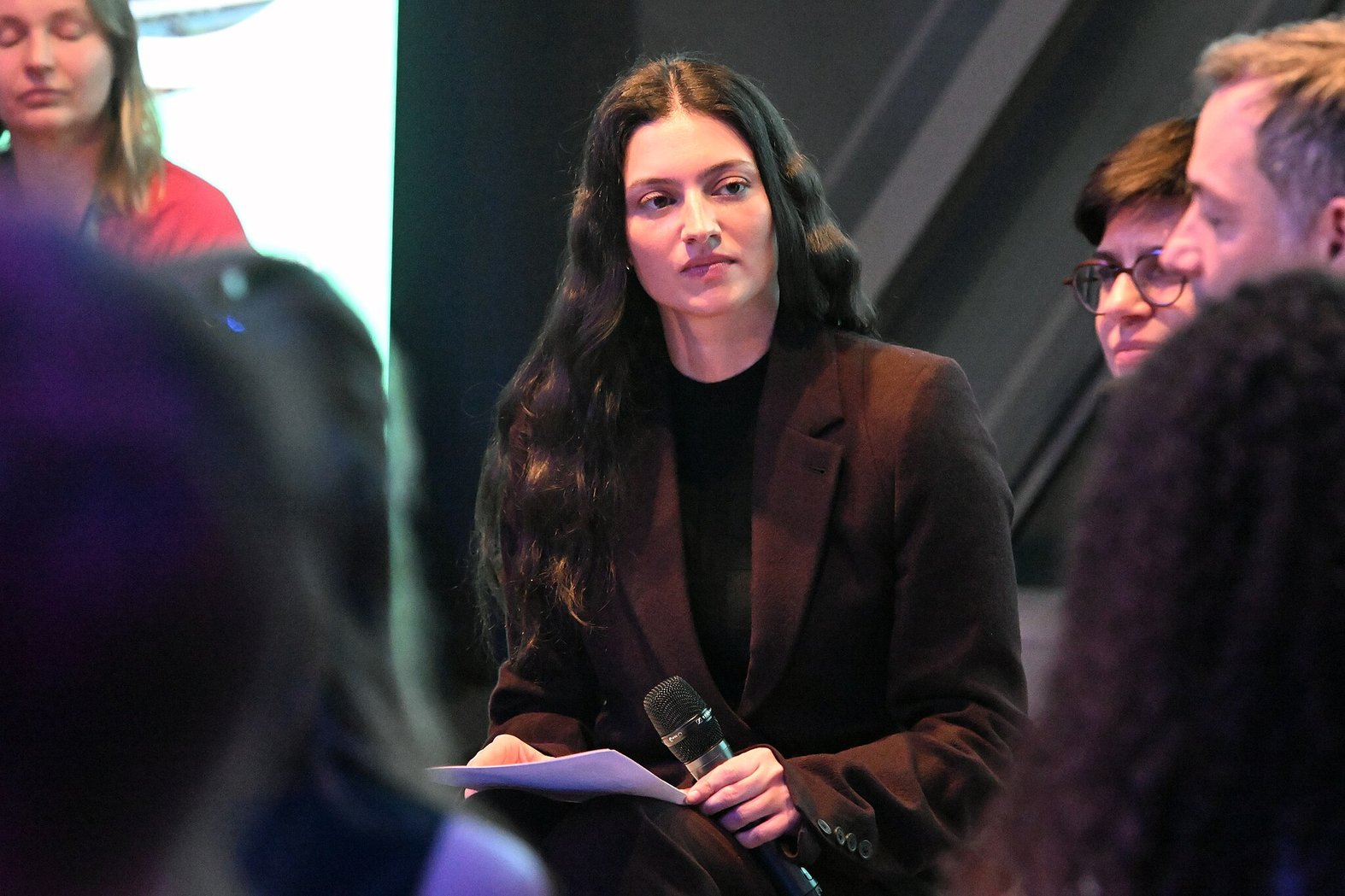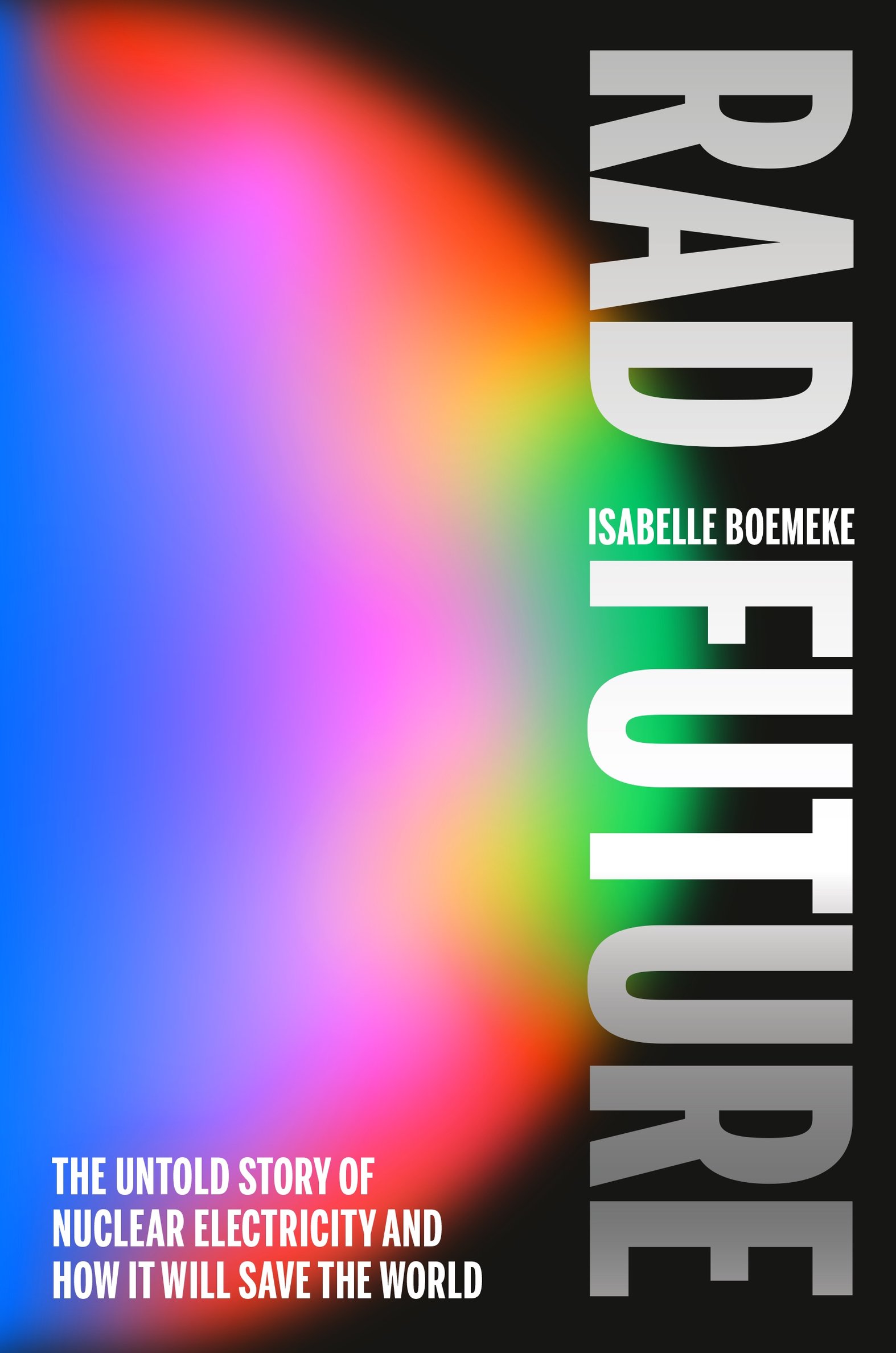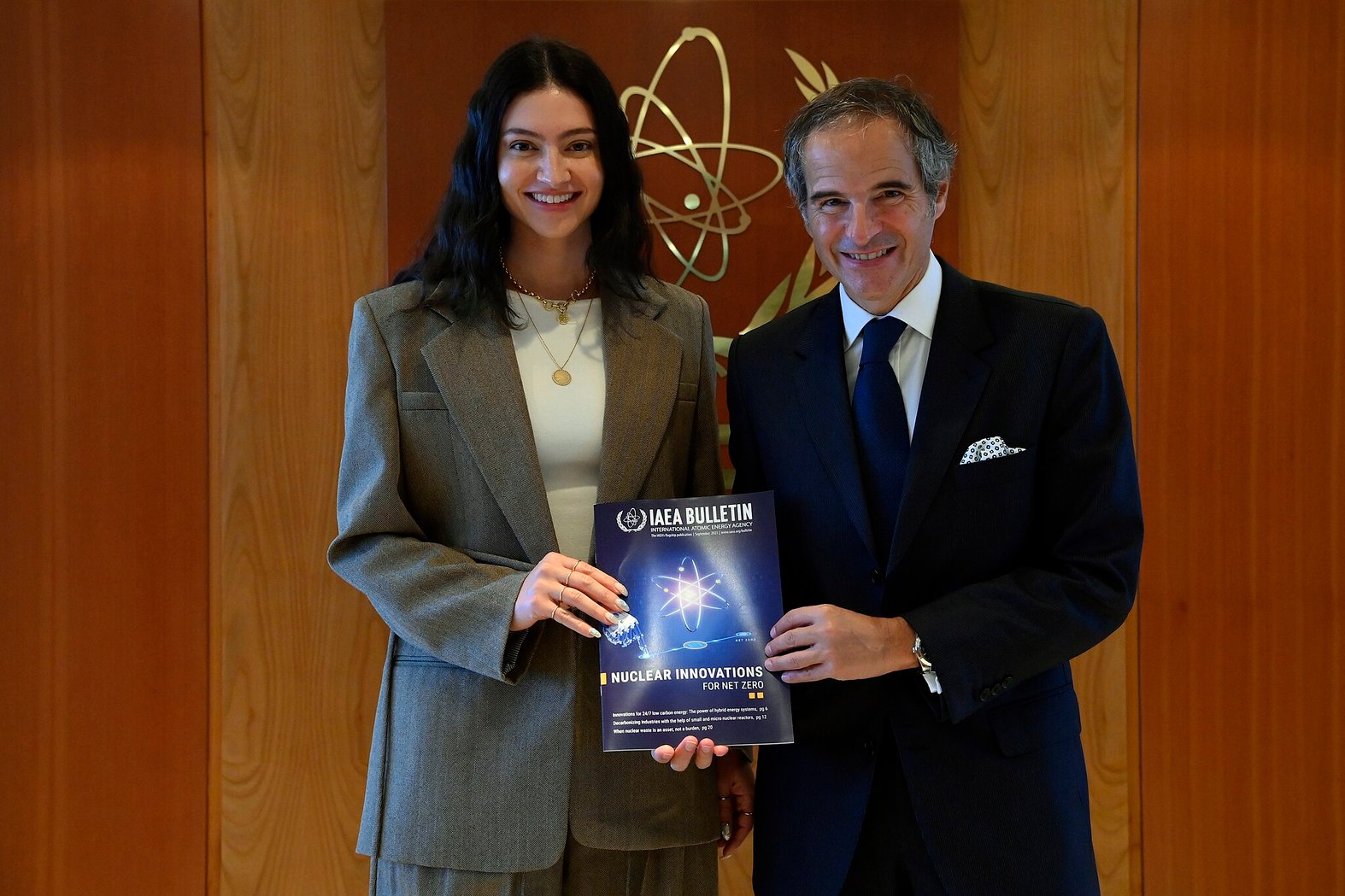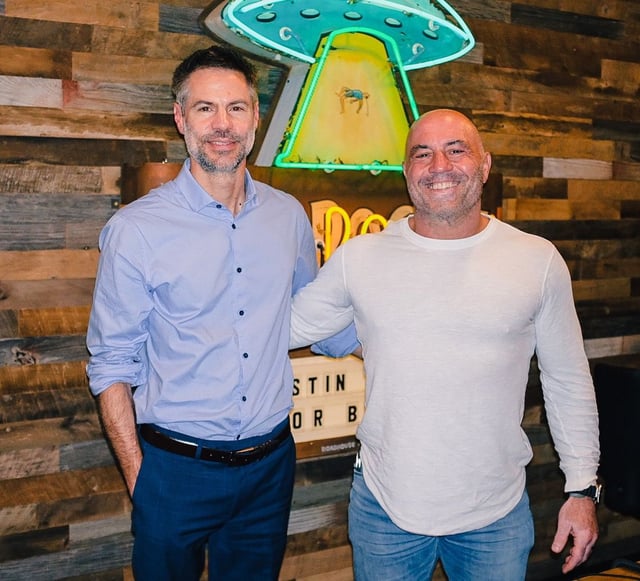
Photo: Isabelle Boemeke moderates a panel during the 2024 Nuclear Energy Summit, “Powering tomorrow, Today”, in Brussels.
Isabelle Boemeke is not trying to accuse Friends of the Earth of shilling for Big Oil – she is. According to the Brazilian model, entrepreneur, and pro-nuclear influencer the story goes something like this: at some point in the 1960s a wealthy oilman named Richard Orville Anderson, chairman and chief executive of the Atlantic Richfield Oil Company (ARCO), handed mountaineer and conservationist David Brower a check worth (USD) $200,000 to start environmental group Friends of the Earth. Brower had been the first executive director and a longtime member of the Sierra Club, a prominent environmental group at the time, but an internal bust up over nuclear power ended with the cantankerous Brower leaving. In Boemeke’s telling, Anderson, a friend of Brower’s, was a philanthropist who funded several environmental groups, and was more than happy to fund Friends of the Earth, especially if they attacked nuclear. According to Boemeke, he was afraid the clean, safe power provided by nuclear energy would undermine his oil business.
In Rad Future, published by Penguin imprint Thesis, Boemeke writes::
Effectively, Friends of the Earth was founded as an antinuclear environmental organization. The founding donation of $200,000 was provided by Robert Orville Anderson, the owner of—drumroll, please—the Atlantic Richfield oil company. Yes, an oil magnate jump-started an environmental dedicated to fighting nuclear electricity. Can’t say I’m shocked. I’m not trying to accuse Brower or Friends of the Earth of shilling for big oil. But it’s interesting that a fossil fuel mogul would write a big check to a brand new organization. It’s especially interesting, considering that Friends of the Earth’s main difference from far established environmental nonprofits was that it was advocating against nuclear.
What’s more interesting is that there is no evidence for any of this. Drilled contacted science historians Professor Cyrus Mody and Assistant Professor Odinn Melsted from Maastricht University to check, and both described this tale as a “conspiracy theory”. In a twist, the historians say the idea appears to have originated in 1970 with a polemic published in the left-wing magazine Ramparts that railed against the “eco-establishment”:
"Finally, the grass roots were given the word. RFF, Ford and Rockefeller had long worked with and financed old-time conservation groups, from Massachusetts Audubon to the Sierra Club, and now the big money moved beyond an appreciation of wilderness to a greater activism. When, for example, David Brower broke with the Sierra Club, it was Robert O. Anderson of Atlantic Richfield and RFF who gave him $200,000 to set up Friends of the Earth (prudently channeling the donation through the organization's tax-exempt affiliate, the John Muir Institute)."

Pro-nuclear bloggers and essayists, such as public relations guru Michael Shellenberger – who Boemeke cites favourably in her book – have since picked up this story as proof the nuclear industry has been victimized and put-upon. The first problem for those promoting this idea is that during the 60s and 70s, oil was not used for generating electricity to any significant degree, meaning Anderson’s oil business would not have been in direct competition with nuclear. The other problem, Mody says, is that there is no evidence it happened.
“Long story short, ROA did not directly bankroll David Brower to start Friends of the Earth,” Mody says. “And whatever support he gave to Brower (financial or otherwise) was not connected to the nuclear question (and certainly not intended as a way to undermine nuclear energy).”
Like all conspiracy theories, of course, this one does contain a fuzzy truthiness. According to Mody and Melsted, there is evidence to show Anderson did provide seed funding to the John Muir Institute (JMI), a separate environmental organization, at a time when Brower was running the organization, after he had left the Sierra Club. In later years, Mody says, Brower “lazily” described this act as Anderson financing the founding of Friends of the Earth but there is no actual evidence the oil tycoon gave the group any money, or that he intended for them to engage in anti-nuclear advocacy. Likewise the $200,000 figure claimed by Boemeke appears to have been taken from the Friends of the Earth US Wikipedia entry, which itself appears to be sourced to a pamphlet published by an anti-banking conspiracy theorist.
“The only money for which I found actual evidence is a (USD) $10k pledge by Anderson to set up the John Muir Institute, and another $60k to the JMI (not FoE) to pay for the salary of Brower and other expenses in relation with the conference that they organized at the Aspen Institute in 1970,” Melsted says.
None of this has stopped public figures such as Shellenberger, who Boemeke campaigned with to stop the Diablo Canyon nuclear plant from closing and whose work she appears to draw upon over the course of her book, from suggesting an oil-drenched conspiracy. Writing in his self-published blog on Forbes.com, Shellenberger selectively quoted from a biography of David Brower written by his former colleague Tom Turner. Read the source material itself and you’ll find another problem with Shellenberger’s, and in turn Boemeke’s retelling: Brower wasn’t anti-nuclear at the time. Turner records, sometimes in forensic detail, that Brower’s concern at that time was about the site chosen for the Diablo Canyon nuclear plant, not the technology itself – a fact Brower himself confirmed in an interview in 1976. During his time leading the Sierra Club, Brower described himself as having “been a staunch supporter [of nuclear power] for a good many years” and spoke about his impatience with more radical anti-nuclear activists. He attributed his later concerns over the safety of nuclear power to a book published in 1970 by Gene Bryerton titled The Nuclear Dilemma.
Contrary to the claims made by both Shellenberger and Boemeke, Brower left The Sierra Club after a long, drawn-out conflict involving a broader ideological dispute with more conservative conservationists, bitter internal infighting, and disputed allegations of poor financial management. Turner similarly reports that Anderson did not give Brower money to start Friends of the Earth – Brower himself denied that any donation had taken place – but did give money to found the John Muir Institute. There is no evidence that Brower transferred money from the institute to Friends of the Earth, but Brower did later claim to have secured a $30,000 advance from the McCall publishing company, which he then used as seed money to help start the environmental group.
Drilled also spoke to friends and former colleagues of Brower in an attempt to independently verify Boemeke’s claims. None had direct knowledge of his business dealings with Anderson, but one person who knew and worked with Brower described him as someone who would take “money from anyone, marching orders from no one”; another said he “was in no way for sale”. Those who knew Anderson described him as an “intellectual, a philanthropist and, in his own way, an environmentalist” and as someone who fought his battles in the open, not the shadows.
None were surprised that Anderson was a conservationist. One person described how lawyers and executives at major companies at the time were often “outdoorsman” who would flash their Sierra Club membership cards during negotiations when their companies were being sued for environmental harms. A similar dynamic would be repeated between Brower and Anderson in 1970. Almost as soon as Brower had taken money from Anderson, he began a doomed campaign against a proposed oil pipeline in Alaska in which ARCO had a financial stake. Afterwards, Anderson stopped donating to Brower’s organizations.
This is not the only questionable and contextless claim made by Boemeke regarding allegations that the US oil industry sought to undermine nuclear power. At another point, she writes:
“In the 1980s, Exxon, a big player in the oil and gas game, poured funds into groups opposing nuclear electricity like Friends of the Earth and the NRDC. Its aim was to create doubt about climate science and, surprise, surprise, to promote the idea that nuclear wasn’t a viable solution.”
No reference or citation is given for this claim, and Drilled was unable to independently verify it. It is worth noting that Exxon has funded nuclear research at different times in its history – though this does not mean the company wasn’t above funding groups opposed to nuclear when it suited. There is just currently no evidence to support this claim and neither Boemeke, nor her publisher, supplied any.
Drilled was approached to interview Boemeke about Rad Future prior to its release and was provided a prepublication copy of the book. It is not known what information remains in the printed copy or whether changes were made prior to publication after a fact checking process. Drilled sought to contact the publisher and a publicist representing Boemeke to ask about these issues and other factual inaccuracies, but did not receive a response.
The kind of behaviour and activity Boemeke alleges is not unknown in the annals of corporate history. Between 2007 and 2012, billionaire fracking pioneer Aubrey McClendon contributed $26m to the Sierra Club, for example, to oppose the construction of new coal-fired power stations and push the narrative of gas as a “bridge fuel” to bolster demand for his company’s gas. It is similarly well-established that the U.S. oil company Exxon led a multi-decade effort to spread fear, uncertainty and doubt about the science of climate change, and funded opposition to various alternative energy solutions. There is, however, no good evidence to support the claim that U.S. fossil fuel producers sought to suppress nuclear power. In fact, many large uranium miners such as BHP and Rio Tinto have historically maintained oil, gas and coal interests at various points in their corporate history and would, arguably, have welcomed a bigger market. Even Richard Orville Anderson’s 2007 obituary in The New York Times notes that he was both a Reagan Republican and, in fact, supported nuclear power. Were Anderson alive today, he might actually find himself in agreement with Boemeke on many issues.
For a curious book, the lack of curiosity in Rad Future is remarkable – particularly for Beomeke who describes herself to interviewers as “like a huge science nerd”. A biography supplied by her publicist when promoting the book described it as a “provocative debut” and “a scientific and unconventional manifesto positioning nuclear electricity as a key solution to the climate emergency.” By her own account, Boemeke is not a journalist, a wonk or a nuclear engineer. Asking, rhetorically, why anyone should listen to her, she writes that her readers might consider her “a sort of translator” who makes “complicated and boring stuff easy and fun to understand.”

Rafael Mariano Grossi, IAEA Director General meets Nuclear Energy Influencer Isabelle Boemeke at the IAEA 67th General Conference held at the Agency headquarters in Vienna, Austria. 26 September 2023. Photo Credit: Dean Calma / IAEA
“I’m not presenting any original science or resorting to obscure references and every piece of data in this book has been factchecked by multiple experts,” she says. “Opinions and sass, on the other hand, are my own.”
Contrary to this, it appears several claims Boemeke makes in her book were not independently fact-checked – Drilled attempted to contact her publisher and publicist to raise multiple factual issues, to ask about the process for verification and which experts reviewed the manuscript, but did not receive a response. This, perhaps, underscores the reality that Boemeke’s true talent lies in marketing, or more specifically, propaganda – and her reach sets her apart from the run-of-a-mill advocate. A model, Boemeke created the online persona Isodope – an “alien-looking avatar inspired by a medley of my favourite artists” along the lines of Ziggy Stardust – as a vehicle for her nuclear advocacy in 2021. Her social media videos are targeted to impressionable young Gen-Z women who might otherwise be looking for advice about make-up techniques or gym routines.
Throughout her book Boemeke gives the impression of wanting to talk about nuclear but she clearly wants to talk about ideas – specifically, the idea of nuclear power. Unfortunately, the ideas Boemeke promotes aren’t hers. They’re all the usual talking points, arguments and jokes made by the very online, pro-nuclear crowd, rendered in the language of TikTok and given a high gloss finish. Specifically, Boemeke says she wants to talk about the idea of “a future of radical abundance and human flourishing for all, not just for people in rich countries. A future where electricity is clean and has less impact on the planet and human health. A future where wars aren’t funded by our addiction to fossil fuels.” As a long-term vision of the future, this is noble, but it is also an embrace of the abundance doctrine, which, ironically fossil fuel barons David and Charles Koch began promoting in the 1980s as a mechanism for pushing back on corporate regulation. In more recent years it has been picked up by YIMBY housing advocates, ecomodernists, and the political pundit Ezra Klein.
Contrary to speculation online, Boemeke doesn’t work for the nuclear industry – that would be gauche. She’s an investor. This means she does stand to benefit financially if the nuclear industry experiences a sudden take off. At the core of her conviction, however, lies a set of beliefs, shared by the wider constellation of pro-nuclear advocates she associates with, that largely involves fighting with shadows cast by strawmen. The starting point is an ideological framework that draws a simple false binary where the world is made up of two types of people: positive-thinking pro-human technologists who embrace nuclear power as an energy source of the future, and negative, corrupt, killjoy Malthusian degrowthers who hate humanity and nuclear out of irrational fear or greedy self-interest. Like other self-described “reformed” environmentalists operating in this space (most famously Shellenberger), Boemeke’s story of her personal intellectual and political development follows the same narrative structure used by Christian evangelical preachers who talk about being led astray before their eventual rejection of Satan and spiritual rebirth.
“It’s cringe to admit but I was fully bought into that [second] way of thinking, like so many of those around me,” she writes. “Our conversations turned to how irresponsible it was to have kids, because of their carbon footprints. As if humans were leeches whose only contribution was more CO2.”
“Despite how messed up this people-hating nonsense is, it has stuck.”
Having found the glowing iridescent light of nuclear progress, she later concludes: “I prefer to see us as creators – creators of love, art, of knowledge and of the future.”
It shouldn’t need to be said, but virtually no credible environmentalists claim “humanity is a virus”, and those who do are doomers who tend to be universally despised by the broader movement as annoying, difficult to work with and defeatist. This false binary, however, is not surprising given Boemeke’s personal circumstances. Boemeke began life as the daughter of a middle-class Brazilian family. She dropped out of school to chase a modelling career which gave her the opportunity to travel the world, where she encountered the reality of the global class divide. A lifetime later, she now has powerful friends and air conditioning. Her husband, a billionaire, helped found AirBnb, and holds senior positions in the Trump administration, one focused on design and the other as part of Elon Musk’s Department of Government Efficiency program, or DOGE, aimed at cost-cutting within the U.S. government. He also sits on the board of Tesla. Billionaire Elon Musk is quoted favorably in Boemeke’s book. She counts Grimes as a personal friend who, Boemeke explains, lent her support to her activist campaign to keep the Diablo Canyon nuclear plant open. The pro-nuclear Breakthrough Institute is name-checked and its co-founder, PR guru Michael Shellenberger, from whom the organization has actively distanced itself in recent years, is falsely described as a journalist throughout the book. Upon publication, Gwynth Paltrow hosted Boemeke in the Hamptons, where they posed together with a copy of the book. Boemeke also posted photos of American singer Katy Perry, holding a copy of Rad Future in public. Boemecke herself maintains a nonprofit, Save Clean Energy.
In this way, her framework for thinking about the world appears to be shaped by the thinking of a small group of well-connected wealthy business people and industrialists, largely concentrated in North America and associated with California’s tech industry. One conclusion that may be drawn from this is that Boemeke’s quest to change the world is less about promoting certain ideas in the best interest of humanity, and more about what her rich and powerful friends think is best for humanity.
All of this goes some way to explaining how Boemeke picks her fights. Fossil fuel executives make for convenient bad guys because everyone already thinks they’re bad guys. Boemeke’s true disgust is reserved for a more devious foe: Friends of the Earth and other environmental activists who get in the way of what she and her friends think is progress.
In particular, her attacks on the ghost of David Brower function as an indirect assault on the credibility of the living. In particular, Stanford physicist Amory Lovins, a long time advocate against nuclear power, is singled out for a villain-edit over his long-time association with Friends of the Earth; he is described as an “energy nerd” and “basically the daddy of the ‘100 percent renewables’ idea” who, along with his “groupies” has “arbitrarily” decided that renewables – not nuclear – are the best way to address climate change. Drilled contacted Lovins who described any suggestion Brower took money from an oil executive to attack nuclear as “absurd”, saying “it would be laughable if it were funny”.
He said he had no record that Boemeke sought to contact him before publication to allow him to respond to any criticisms she had of him, and said that her version of history was “wrong from end to end”. Lovins suggested that Stanford Professor Mark Jacobson was a better candidate for the title of “daddy of 100 percent renewables”, even if he had come to similar conclusions after “an independent intellectual pursuit in the public interest, not a religion or cult”. He added that he was surprised to learn he had “groupies”, and that the pursuit of renewables to address climate change is not “arbitrary” as Boemeke suggests, but supported by “science and data” showing that renewables are “the best buy and the cleanest, safety, fairest and most secure choice” for responding to climate change.
“I gather that Ms. Boemeke knows little about the subject and less about me and my work,” Lovins said. “My 2011 book Reinventing Fire would be a good place to start. My general profile is [available online]. And scholarly papers on how to run various regions (or the world) on 100% renewables are not just “several” but over a thousand: start with [this] and [this].”
Boemeke’s treatment of renewables is patronizing, and appears to be cribbed from Shellenberger, who has history with Lovins. Lovins described once being invited to debate Shellenberger “on a topic that turned out to be different than the one we’d agreed,” adding that “[Shellenberger] didn’t do well”. Wind and solar are great, Boemeke does explain, even as she tells her readers that “sometimes the sun barely shines, or the wind barely blows for days at a time” with the same enthusiasm as an oil and gas CEO. Along the way, she repeats all the usual nuclear industry talking points – nuclear is safe, creates jobs, nuclear is the only way to reach net zero, and, of course: a person’s lifetime nuclear waste is about the size of a coke can – itself a Facebook meme created by the Canadian Nuclear Association.
As an exercise in nuclear industry propaganda, Rad Future is painfully mid. This is not the full story, of course, and the book has other issues – but then Boemeke does not expect her readership to pay close attention to anything. As she writes: “there is no wrong way to read this book – and skimming is encouraged.”
“You don’t need to know everything there is to know about nuclear to become a good advocate for it,” she writes.
So long as Boemeke’s readers leave with the vibe that “nuclear good”, it’s job done. None of which is surprising. In both politics and Instagram, follows are currency. Getting new recruits to like and subscribe, however, takes hustle. Whether you’re slinging eyeliner or second-hand ideas to soldiers for a cause, the trick is to never let the whole truth get in the way of a quick sale.
Editor’s note: Drilled’s headline on an earlier version of this story introduced a typo mis-identifying Boemeke as Isabella Boemeke. Her name is Isabelle Boemeke. We regret the error.

